Winter Climbing Planning and Decision Making
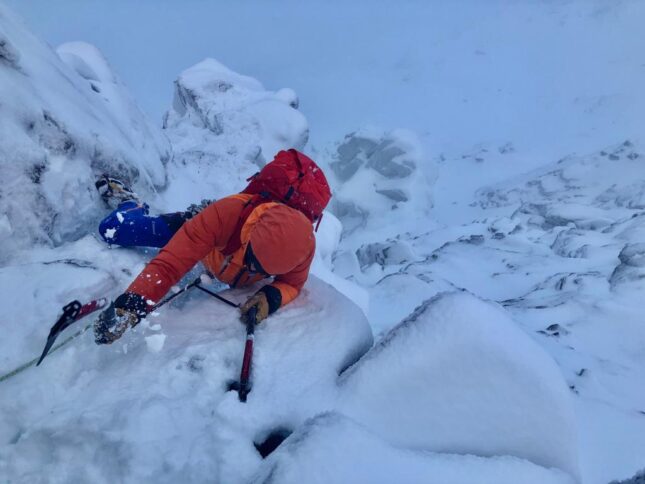
Who, what, where, why, when
Ready for a winter climbing adventure? Here are some key things to think about when planning for it and making decisions on the day.
WHEN in the season is best and what can you expect?
Weather and winter conditions in Scotland have famously always been hard to predict and this is maybe what gives it that special appeal. In recent years there have been some unusual patterns and unusually warm periods when we’ve seen mid-winter temperatures rising and the freezing level above the summits.
Freeze/ thaw cycles and stormy patterns have always been normal for Scotland and important to the formation of good snow build up and ice. So whilst there are some seasonal averages that we can expect, recent winters have also proven there can be extremes too.
Early season
- Short days/daylight hours
- Little snow build up, buttress and ridge climbs will be better
- Avoid gully climbs that require good snow build up (they will feel harder/not possible and often have loose rock)
Mid-season
- More daylight
- A wider knowledge of current conditions and winter climbs
- Gully climbs may be possible, still be cautious if good snow build up is essential
- Crag aprons will be snowy, and cornices will be developing too
- More snow on mixed buttress climbs and on ridges
Late season
- Longer daylight hours
- Good established snow base (normally!)
- Possibly large cornices
- Ice climbs and steep gully climbs more of an option
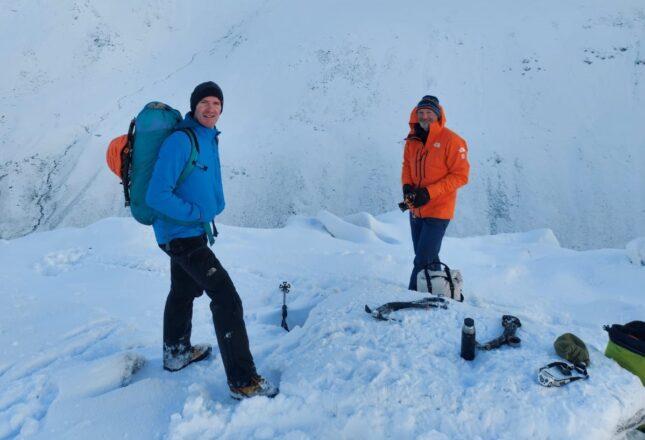
WHAT to climb or which route?
This will depend on current conditions and weather expected on the day.
The winter mountains of Scotland have every kind of adventure you might be looking for and most are world class. Scotland’s winter climbing and mountaineering is respected throughout the world, and often due to the challenging weather and testing conditions you can experience.
Start with the established classic climbs in the popular mountain areas, then in time, if this is what you want, head for more remote adventures – there’s plenty to choose from in Scotland.
Social media and blogs have become a good source of current conditions information and may inspire/help you choose the route you want to climb. Although, remember, many will declare a good climb, but was it really? Guidebooks have and are becoming better all the time, along with larger reference books such as Cold Climbs and more recently Chasing the Ephemeral.
Combined with the current mountain weather reports and conditions awareness, consider whether it is early, mid or late season? This can help direct your thoughts and inform the style of route and area you choose to climb in.
As we’ve looked at, early season, mid and late all have their own characteristics. Remember that conditions can affect the grade of the winter climb greatly. Snow build up may make the climb feel easier, but you’ll also find that protection may be harder to find, for example ice filling the cracks. This will make your chosen route feel quite bold.
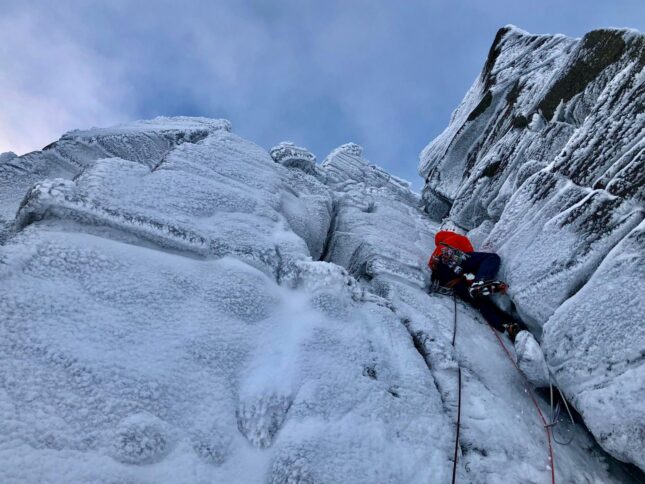
WHY am I going out winter climbing?
There are some risks we need to manage and again this is part of the appeal of the winter mountaineering challenge. First, we need to know what risks there are before we can start to manage or prevent them. Every time we head out in to the mountains, we are making mini risk assessments all day and at the end of the day reflecting with a beer or cup of tea in front of the fire is a form of review.
This experience never stops building and is so valuable to your climbing team. Share and learn from others in your climbing team or even wider.
One of the first questions you may ask yourself is why are we going out, why today? Does it feel right or is it just because it’s your only day off?
There are some heuristic traps that are worth knowing about in the mountains –
Over commitment to a goal:
Don’t just press on because you feel you have to, being able to turn around if things don’t feel right or weather and conditions aren’t good.
Familiarity of terrain:
Just because you may have been over some terrain several times before, doesn’t mean it must be ok.
Scarcity:
You only have one day off and you’re going out into the mountains as the opportunity doesn’t arise often. This doesn’t mean you should ignore the warning signs and potentially carry on regardless.
Social proof:
Just because someone has climbed the gully or descended that slope before you, doesn’t mean the route is safe. Consider current conditions and factors.
Expert halo:
Someone in your group may have a little more experience than you, however, that doesn’t mean you have to follow regardless. It’s healthy to have an open culture in your team and everyone have a voice and feel they can contribute.
These heuristics are often referred to in avalanche risk assessment and decision making, which forms a continuous part of our winter mountaineering and climbing planning. Avalanche risk must form part of your planning and dynamic risk assessment throughout the day in the mountains and with snow build up and extremes of weather patterns the avalanche risk can be complex at times.
One way of helping you learn and understand more about the avalanche risk is to monitor and read the avalanche forecasts regularly and through the winter, not just the evening before your mountain day. This will help you see weather influences and recognise how it effects the avalanche conditions through the winter. It will also help you understand some terminology used and help your own avalanche assessment skills and learn what to look for on the mountain. Alongside sportscotland’s Scottish Avalanche Information Service (SAIS) forecast you’ll find forecasters blogs. This is a great way of finding out more beyond the forecast, often with photos, these give you a daily description of conditions found in that certain area.
SAIS have a great planning tool available which helps you learn lots about the avalanche risk, decision making and planning. Check out Be Avalanche Aware.
Consider getting a bit of training to increase your Avalanche Awareness.
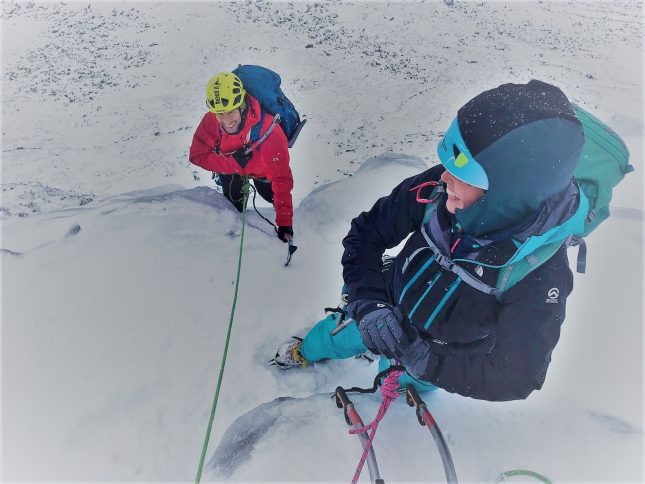
Where to climb?
This may depend on a few things including how much time you have free and where you are based. The season and the level of snowfall will all influence your choice of mountain area and style of route.
In Scotland there are rightly popular winter climbing areas, all of which have varying levels of infrastructure and relevant climbing information: Northern Cairngorms, Southern Cairngorms, Ben Nevis and Glen Coe, Creag Meagaidh, North West Highlands and Isle of Skye.
All the areas mentioned also have varying styles of climbing and are best suited to certain conditions and times of the winter season. Familiarise yourself with these characteristics.
All areas have mountain weather forecasts and Avalanche forecasts specific to that area. This provides us with incredibly valuable information when planning and trying to evaluate conditions.
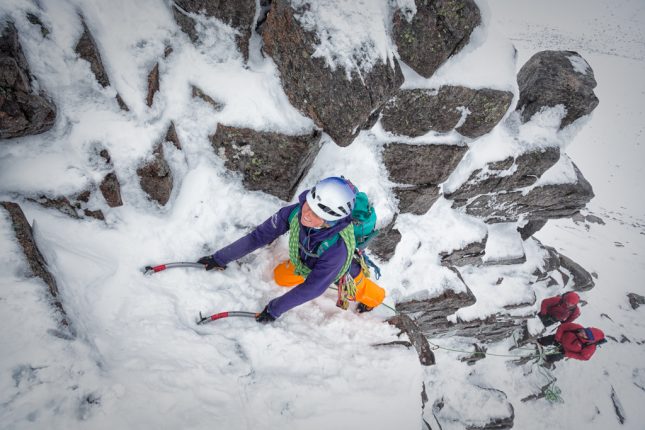
WHO with?
Do you already have a regular climbing partner or a pool of friends to call upon? It’s normal to climb as a pair and traditionally makes it easier in many aspects such as; planning, time off work, rope management on the route, more space on belays/stances and maybe what you’re both used to.
However, there are many advantages to winter climbing as a team of three. Weight of climbing equipment can be shared, and this especially helps on long approaches or big mountains. Decision making can be made easier with more minds sharing the responsibility, again helpful on long routes or a big mountain.
Something to consider and maybe give it a try one day if new to you?
There are pros and cons with either option and maybe something to try on a summer rock climb first, as the greatest challenge and trade-off is the rope and stance management whilst climbing as a team of three.
Test the water slowly and progress from there, especially early season. Develop your systems and skills – clothing, equipment and climbing rack…keep fit, flexibly-minded. armed with information as well as equipment. Adventures and success will happen.
A final piece of advice. Be prepared to turn around if things don’t feel good or conditions aren’t quite right, or have a plan A,B or C.
#ThinkWINTER